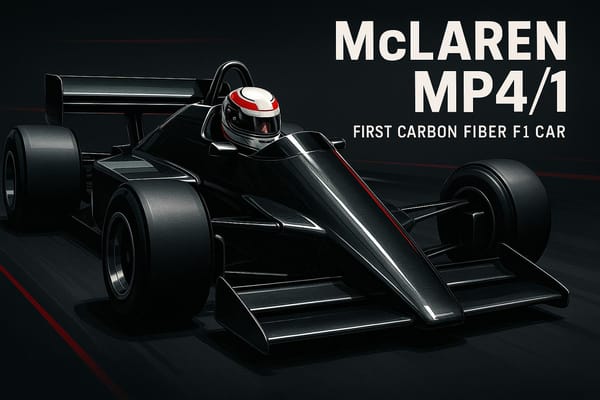Sidepods vs. No-Sidepod Designs in F1
Explore the debate between standard sidepods and zero-pod designs in Formula 1, analyzing their impact on performance and innovation.

Formula 1 teams face a crucial decision: stick with standard sidepods or explore no-sidepod (zero-pod) designs. Both approaches have their strengths and weaknesses, shaped by aerodynamics, cooling requirements, and regulatory constraints.
- Standard Sidepods: Offer better airflow control, efficient cooling, and stable handling. Examples like Ferrari’s 2022 design showed consistent performance but added weight.
- No-Sidepod Designs: Aim to reduce drag and improve efficiency but struggle with cooling and handling issues. Mercedes’ 2022 experiment with zero-pods highlighted these challenges, forcing a return to conventional designs mid-2023.
Key Takeaway: While no-sidepod designs pushed boundaries, they lacked practicality and reliability, proving that gradual refinement often outperforms radical changes.
Quick Comparison:
| Aspect | Standard Sidepods | No-Sidepods (Zero-Pod) |
|---|---|---|
| Aerodynamics | Balanced airflow and cooling | Drag reduction focus |
| Cooling Efficiency | Larger systems, reliable cooling | Limited capacity, prone to issues |
| Handling | Predictable across conditions | Unstable, porpoising problems |
| Weight | Heavier due to larger components | Lighter, compact design |
| Performance | Consistent results | Struggled, later abandoned |
Mercedes’ experiment underscores the risks of extreme designs. In F1, balancing innovation with practicality is key to success.
The Innovative F1 2022 Sidepods Explained! | F1 TV Tech Talk | Crypto.com

Standard Sidepod Designs: Features and Benefits
Standard sidepods have long been a reliable answer to the aerodynamic and cooling demands of modern Formula One cars. These elongated structures strike a balance between performance and engineering complexity, making them a staple in F1 design. Let’s explore how these sidepods deliver in terms of aerodynamics, safety, and overall efficiency.
Aerodynamic Performance and Cooling Systems
One of the standout features of standard sidepods is their predictable airflow management. By guiding air smoothly along the car's sides, they ensure consistent aerodynamic behavior. Inside, they house critical components like radiators and cooling systems, allowing engineers to optimize cooling without compromising design flexibility. This setup supports the creation of efficient inlets and cooling louvers, which help regulate the temperatures of the engine, ERS, and brakes. In short, standard sidepods offer a practical blend of aerodynamic precision and thermal management.
Integration with Crash Structures
Safety is another area where standard sidepods excel. They seamlessly incorporate mandatory crash protection features, such as the anti-crash cone, directly into the bodywork. This integration not only meets FIA safety standards but also maintains clean aerodynamic lines. By merging safety and performance in this way, teams can focus on achieving both objectives without compromise. These safety elements work hand-in-hand with the aerodynamic benefits, creating a well-rounded design approach.
Real-World Examples
Ferrari’s 2022 F1-75 provides a great example of how standard sidepods can deliver results. The car featured large, straightforward sidepods designed to reduce drag and manage airflow effectively over the engine cover. With square sides and triangular intake towers, the design directed air efficiently toward the rear wing while maintaining a slim upper profile. This approach highlighted Ferrari’s confidence in generating underfloor downforce while keeping cooling and structural elements simple yet effective.
Another advantage of standard sidepods became evident during the 2022 season: resource efficiency. Teams sticking to conventional designs could focus their efforts on fine-tuning performance, while those experimenting with unproven concepts often faced higher costs and longer development times. This efficiency allows teams to channel resources into other areas of performance improvement rather than troubleshooting foundational design issues.
Over the years, standard sidepod designs have evolved to align with changing regulations. From the bulky, high-mounted sidepods of the past to today’s sleeker, more aerodynamic shapes, these designs have consistently adapted while retaining their core strengths. This evolution underscores their enduring relevance in Formula One engineering.
No-Sidepod (Zero-Pod) Designs: Features and Challenges
For decades, traditional sidepods have been a cornerstone of Formula One car design, but the no-sidepod - or zero-pod - approach took a bold step away from convention. This concept gained attention when Mercedes pioneered it in 2022, driven by the pursuit of aerodynamic gains. However, while the theory behind the design was promising, the practical results revealed a host of challenges. Let’s dive into how this radical design tackled airflow and what issues it faced.
Drag Reduction and Airflow Management
The zero-pod design aimed to streamline the car by minimizing sidepod volume, which, in theory, would reduce drag and allow air to flow more freely over and under the car's floor. Unlike the traditional sidepod setup, which uses carefully sculpted bodywork to direct airflow toward the rear wing, Mercedes’ design featured a narrower front and reimagined inlets that leveraged the Coanda effect. The idea was to create a stronger pressure differential by directing a full-bodied airflow over the floor, boosting downforce while keeping drag in check. But while this concept looked great on paper, it came with its own set of hurdles.
Technical Limitations and Performance Issues
For Mercedes, the zero-pod approach proved to be a double-edged sword. The team faced significant difficulties in maintaining stable airflow around the car's sides and floor during varying race conditions, leading to inconsistent handling. One of the most glaring problems was porpoising - a phenomenon where the car oscillates violently at high speeds due to uncontrolled downforce. To counter this, Mercedes had to raise the car’s ride height, which compromised their initial aerodynamic goals.
Another challenge was cooling. With reduced sidepod volume, the radiator area shrank, demanding innovative cooling solutions that sometimes fell short during intense races. Additionally, removing traditional sidepod structures exposed critical components like crash structure stays, which were introduced during 2022 pre-season testing. Other teams managed to integrate these elements more effectively, maintaining clean aerodynamics and gaining a competitive edge.
Lessons from Mercedes' Experimentation

Mercedes’ experiment with the zero-pod design highlighted the fine line between pushing boundaries and maintaining practicality in Formula One. As Mike Elliott pointed out, abandoning the concept entirely would have halted their development progress. Instead, Mercedes chose to refine their approach, adapting to the new ground-effect regulations. However, persistent handling issues eventually led them to reintroduce sidepods by the 2023 Monaco Grand Prix, which noticeably improved performance.
This journey underscores the risks and rewards of stepping away from tried-and-tested designs. While the zero-pod concept showcased bold thinking, it also revealed why balancing innovation with reliability is critical in the high-stakes world of F1 engineering.
Direct Comparison: Standard Sidepods vs. No-Sidepods
The 2022 Formula 1 season brought some bold design choices to the forefront. Ferrari leaned into a wide-pod concept that delivered steady and reliable results, while Mercedes went all-in with their radical zero-pod approach. The results? Ferrari’s design offered consistency, while Mercedes faced unpredictable handling across different tracks. Interestingly, Red Bull found a middle ground that outperformed both extremes, proving that pushing boundaries doesn’t always guarantee success.
Let’s break down the trade-offs between these designs by looking at key factors like weight, regulations, and development adaptability.
Mercedes’ zero-pod design prioritized weight reduction with its compact structure. However, this came at a cost. To tackle porpoising, the car needed higher ride heights, which canceled out much of its aerodynamic advantage. On the other hand, Ferrari’s wide-pod design was heavier but incorporated larger cooling systems and stronger structural elements. This showed that shaving off weight doesn’t automatically lead to faster lap times.
Comparison Table: Features and Trade-Offs
| Design Aspect | Standard Sidepods (Ferrari Wide-Pods) | Zero-Pod Design (Mercedes) |
|---|---|---|
| Primary Aerodynamic Goal | Airflow control and cooling capacity | Drag reduction and efficiency |
| Lateral Volume | Large, with a wide surface area | Minimal, compact, and sleek |
| Airflow Management | Keeps airflow along the sides separate | Uses Coanda effect to direct upper flow to the floor |
| Cooling System Capacity | Larger, more effective cooling systems | Smaller radiators with limited capacity |
| Weight Impact | Heavier due to larger components | Lighter thanks to compact design |
| Structural Integration | Hides crash structures and stays | Exposes structural components visibly |
| Handling Characteristics | Predictable across various conditions | Unpredictable, impacted by speed and track type |
| Development Complexity | Straightforward, familiar approach | Radical, requiring significant resources |
| Regulatory Compliance | Fully compliant within established norms | Pushed boundaries, sparking legality debates |
| Real-World Performance | Consistently effective in 2022 | Struggled with porpoising and performance issues |
| Design Longevity | Continued use beyond 2022 | Abandoned by the 2023 Monaco Grand Prix |
While the FIA deemed Mercedes’ zero-pod design compliant with regulations, its unconventional nature raised questions about the intent behind the rules. Ferrari, by contrast, stayed well within established boundaries, avoiding such controversies.
Another key difference lay in development and cooling strategies. Ferrari’s wide-pod design featured a modular radiator setup, making it easier to adapt as needed. This flexibility was paired with a triangular air scoop that ensured reliable cooling, even in high-temperature conditions. Meanwhile, Mercedes’ smaller cooling systems struggled to match this efficiency. By the 2023 Monaco Grand Prix, Mercedes had reverted to a more conventional sidepod design, underscoring the practicality and effectiveness of Ferrari’s approach.
Historical Development and Future Trends
Sidepod designs in Formula One have come a long way, evolving alongside shifts in regulations and advancements in technology. Back in the 1980s, sidepods were high and bulky, prioritizing cooling and stability over aerodynamics. While effective for keeping engines cool, they created significant drag, slowing cars down on straights.
By the 1990s and 2000s, teams began to rethink their approach. With a growing understanding of aerodynamics, engineers started lowering and streamlining sidepods to cut drag and manage airflow more effectively. This marked a shift in philosophy - sidepods were no longer just about housing cooling systems; they became key tools for optimizing airflow and gaining a competitive edge.
The evolution of sidepods has always been closely tied to the FIA's regulatory framework. Rule changes have dictated their size, shape, and placement, ensuring safety and maintaining competitive balance. Each major regulation update has sparked a wave of innovation as teams pushed the boundaries of what was possible within the rules. This was especially evident with the ground-effect regulations introduced in 2022.
The 2022 regulations were a game-changer. They reintroduced ground-effect cars and limited the use of additional aerodynamic elements on sidepods. Teams had to rethink their designs under these tighter constraints, focusing on maximizing the aerodynamic potential of the car's underbody. This led to a variety of sidepod concepts, showcasing just how differently teams could interpret the same set of rules.
One striking example of innovation - and its challenges - was Mercedes' "zero-pod" concept. This radical design aimed to reduce drag and improve airflow efficiency, but it came with significant trade-offs. The design created handling unpredictability and issues like porpoising, which forced the team to raise the car's ride height, compromising performance. Limited sidepod volume also restricted cooling options. After 1.5 seasons, Mercedes abandoned the concept in favor of a more conventional design.
Looking ahead, the next decade of sidepod development will likely be shaped by cutting-edge tools like advanced computational fluid dynamics (CFD) and AI-driven design software. These technologies allow engineers to fine-tune airflow interactions between sidepods, floors, and underbody components with unprecedented precision.
Future designs are expected to focus on integrating cooling systems into compact, aerodynamic shapes. Advances in materials could enable thinner, stronger structures, offering the cooling efficiency of traditional sidepods without sacrificing aerodynamic performance. This approach highlights the ongoing challenge of balancing efficiency, reliability, and regulatory constraints.
The lessons from recent experiments, like Mercedes' zero-pod trial, underline the importance of balancing bold innovation with practical needs like cooling and stability. Experts predict that teams will gravitate toward designs that optimize aerodynamic efficiency while maintaining reliability and compliance with regulations. As rules continue to evolve, so will the experimentation and diversity in sidepod philosophies.
Ultimately, regulatory changes will remain the driving force behind innovation, pushing teams to find incremental gains in performance while adhering to safety standards. The variety of sidepod designs since 2022 has shown how different approaches can yield varying results, influencing the technical direction of Formula One for years to come. This ongoing evolution underscores the delicate balance between creativity and practicality in shaping the sport's future.
Conclusion: Balancing Innovation and Practicality
Sidepod design reflects the constant tug-of-war between bold innovation and practical functionality. Mercedes' ambitious zero-pod concept aimed to reduce drag but ran into challenges with cooling and handling, showing that theoretical advantages don’t always translate to success on the track.
In Formula 1, steady refinement often beats sweeping overhauls. Red Bull’s well-rounded 2022 design and Ferrari’s wide sidepods highlight the importance of blending airflow optimization with effective cooling. This approach emphasizes the value of making gradual, calculated adjustments instead of pursuing dramatic design shifts.
Mercedes technical director Mike Elliott summed it up best: “If you tear it all up and start again, you're going to start further back than where you are”. His words underscore the risks of abandoning tried-and-true solutions without thorough testing. Practical factors like cooling needs, crash safety, and regulatory requirements ensure that even the most groundbreaking ideas must prove their worth under race-day conditions. Teams that can quickly align simulation data with real-world performance gain a decisive edge over those relying solely on theoretical predictions. Mercedes' decision to return to more conventional sidepods in 2023, after grappling with porpoising and erratic handling, demonstrates that flexibility and responsiveness often triumph over radical experimentation.
FAQs
Why do some Formula 1 teams opt for a no-sidepod design despite its challenges?
Some Formula 1 teams opt for a no-sidepod design to boost aerodynamic efficiency and cut down on drag. By shrinking or eliminating the sidepod structure, they aim to improve how air flows around the car, which can lead to faster straight-line speeds and better performance on certain tracks. This design can also lower the car's center of gravity, which might enhance handling and cornering stability.
That said, this approach isn't without its hurdles. A no-sidepod setup often limits cooling capacity, making it tougher to keep engine and brake temperatures under control - especially in hotter race conditions. Teams taking this route have to carefully weigh these trade-offs, finding a way to maintain reliability without sacrificing performance.
What impact did Mercedes' zero-sidepod design have on their performance compared to traditional sidepods?
Mercedes took a daring step with their zero-sidepod design, rethinking aerodynamics to cut down on drag and improve airflow efficiency. While this approach aimed to push boundaries, it came with its own set of hurdles - most notably in cooling and stability. These issues made it difficult for the team to consistently keep pace with rivals sticking to more conventional sidepod setups.
This bold choice didn’t just showcase creative engineering; it also underscored the fine line between chasing aerodynamic advantages and maintaining reliable on-track performance. The design sparked heated discussions within the F1 world, as experts debated whether the potential benefits were worth the trade-offs in such a fiercely competitive sport.
What are the future trends in F1 sidepod design based on recent advancements and rule changes?
Future Formula 1 sidepod designs are set to emphasize better aerodynamic performance and improved cooling systems. A notable trend is the growing adoption of "downwash" sidepod designs. These designs direct airflow downward, boosting downforce and enhancing the car's overall performance. Teams like Red Bull have been leading the charge in refining this approach.
Another significant shift involves raised sidepod inlets. This design creates a more pronounced undercut, which helps optimize airflow along the car's floor edges. Teams are also experimenting with unconventional sidepod inlet shapes, including P-shaped designs, to strike the right balance between cooling the car and achieving aerodynamic efficiency. These advancements demonstrate how teams are constantly pushing design boundaries within the rules to gain an edge on the track.




